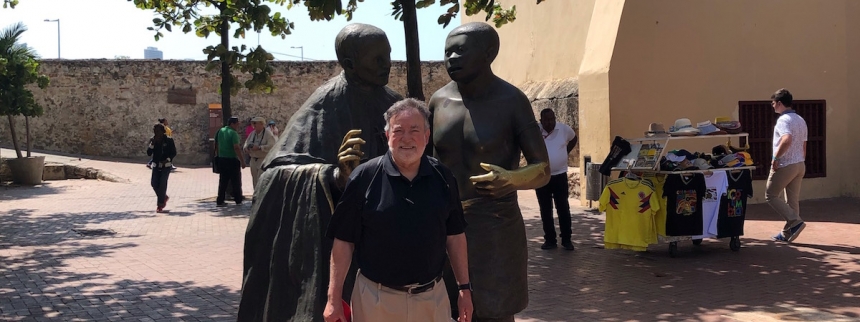
Prior to arriving in Panamá, I made a small personal pilgrimage to the City of Cartagena in the country of Colombia. The ancient port city is only a short 50 minute flight from Panamá City. At one time, the Panamá Isthmus was part of Colombia but then seceded in 1903.
Cartagena was part of a network of Spanish Caribbean ports and like many ports subjected to the periodic ravages of pirates. For this reason, colonial Cartagena is surrounded by a formidable fortification. The ramparts now serve a proud promenade from which to enjoy the ocean breezes and watch the sunset. On a hill near the city was another more militarized fort from which cannons threatened to assail an approaching foe.
Not quite the dimensions of the San Francisco Bay, the harbor and inlets protected by Cartagena were still an attraction for commerce and piracy. Normally a tourist expects to find in an old port city a rusted cannon here and there. In the case of Cartagena, the city was cluttered with an extraordinary number of old cannons, everywhere. This may have been indicative of the old port’s vulnerability and the lawless marauding conditions that plagued the Spanish ports of the Caribbean.
In one corner of the walled city, was nestled the primary reason for my interest in this old port. In that corner, close to the ancient customs house, was the old Jesuit house and church of St. Peter Claver. The proximity of the church and the religious residence to the customs house was no coincidence. The customs house, next to the old docks, oversaw the coming and going of trade from the galleons traversing the Atlantic and crisscrossing the scattered cluster of Caribbean islands in the Gulf of Mexico. It also administered the business of human slavery.
Cartagena was where many African slaves were brought to South America. Cartagena is still home to many descendents of the enslaved men and women brought against their wills to the American continent. The Jesuit, St. Peter Claver, dedicated himself as the “slave of the slaves”. He waited for the ships coming into the Cartagena to care for the unfortunate souls savagely shipped and shackled. It is claimed that he baptized more than 300,000 slaves. His legacy still haunts the streets of the city where the Afro-Latino culture has found a way to thrive in spite of its difficult past, perhaps because of the works of mercy by this holy priest.
The colonial building where Fr. Peter Claver lived is still a Jesuit House. The first floor and parts of the second floor where given over to a museum and shrine to Fr. Claver. I visited his room which would have looked out upon the town square, next the dock, where the heartless slave market was conducted. The heroism and extraordinary charity of this remarkable Jesuit can only be understood once one grasps the repulsive horror of colonial human trafficking. More disturbing still was the social acceptance and legal accommodation for this moral outrage. Any lingering reflection on this saintly life must also shudder at the sin against which St. Peter Claver labored.
In these past days, we have marked the tragic anniversary of the Supreme Court decision, Roe v. Wade, legalizing the reprehensible practice of abortion. The Church’s opposing testimony, expressed in teaching and practice, advocating for the dignity of young lives in the womb can seem as meager as Peter Claver’s boarding slave ships to care for the sick. As his legacy lives on in those who remember his patient, faithful, merciful persistence so will our continuing fidelity to the Lord Jesus and His gospel of life and dignity if we continue to keep in mind the words of St. Paul practiced so eloquently by St. Peter Claver: “There is neither Jew nor Greek, there is neither slave nor free person, there is not male and female; for you are all one in Christ Jesus.” (Gal. 3.28)
---
Read Bishop Soto's dispatches from World Youth Day: Day 1 - Day 2 - Day 3 - Day 4 - Day 5 - Day 6 - Day 7

